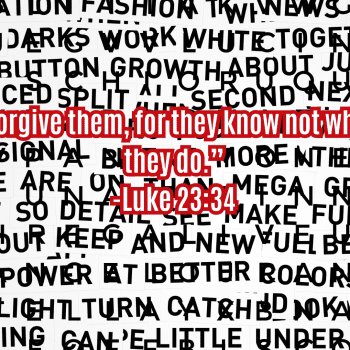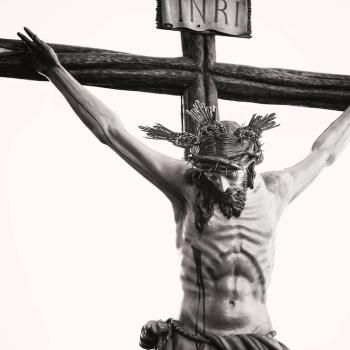
You cannot take a picture of a general “mother” or “child.” You cannot photograph the idea of “pregnancy,” “family,” or “abortion” — only this pregnancy, this family, and this abortion. A photograph of a child is always of a real, particular child, who stood at a particular place and a particular time and had his photo taken. Photography is always photography of the real.
The difficulty for the pro-life movement is that, as it works for the abolition of abortion, it uses pictures of children, not as pictures of this or that real, particular child, but as stand-ins for “the child in general.” When a stock-photo of Mitchell, a beautiful baby, forms the background of a sign that reads “Protect Life,” no one imagines it is demanding that we protect Mitchell’s life. Mitchell has since grown up into a pimply, 19-year old communist working at a 7-11. We do not see him in the image. We see the general idea of “the child.” He has become a symbol. The rhetorical success of the baby-sign depends on us seeing “through” Mitchell and towards the general idea of “baby,” “child,” “person.” The image presents the person anonymously — and anonymous images can inspire apathy in the gaze that sees them.
We do not feel the value of general ideas. We can understand that “human beings” have dignity — sure. It’s easy enough to know that free, rational and moral agents have value; that people are beautiful, noble, complicated, and poor. But we will not shudder, quiver, gasp or otherwise feel these values unless we move from knowing-about the human being to seeing, touching, and living with him. Nobility, beauty, poverty, dignity — we feel these values when we encounter them embodied in an actual person.
Christ did not give us a new commandment — to love the human person as ourselves. He demanded we love our neighbor, a Hebrew word that means “near-dweller.” The nearness of the person enables us to encounter that person as valuable. His nearness means that we can enter into some kind of real relationship with him — a communion in which he matters to us, affects us. I cannot enter into a relationship with the general idea of the child. The “unborn baby” does not pierce my heart with felt value. Even the “pregnant mother,” as much as the idea can evoke some sentimental response, does not evoke a genuine perception of value. I value a person when I make the movement from knowing-about her to an encounter with her. I am vulnerable to having my heart pierced precisely when I refer myself to this pregnant mother who can really matter to me.
If the particular human person (who is valuable) is presented as an icon for the generalized idea of a person (which, as a non-existing general concept, lacks value) are we surprised that the gaze which falls on such a sign remains unimpressed by the value of the person? Are we surprised that we can look on the smiling baby and not care; on the aborted fetus and feel nothing but light, medical distaste; on the wholesome, pregnant mother and walk into the abortion clinic? It does not surprise me. This is the radical contradiction at the heart of pro-life protest.
The baby-sign demands respect for the dignity of real children by using real children to represent a general idea. The pro-life billboard begs the world see the value of the unborn person in a mode that treats him as an impersonal type. We advocate for a holistic vision of pregnancy by wielding signs that mutate pregnant mothers into symbols for protest.
There is an irreverence in our demand for a newfound reverence towards the human person; an instance of convenient use in our protest that no child should be the victim of convenient use. The unique value of the person is not shown, but hidden by the act that duplicates his image across a thousand yard signs. The immense dignity of the individual is not displayed, but obscured when we blazon his image across signs, edit him and alter him, add our captions and logos, and take to no care to know who he is.
Imagine, if you will, that we had a genuine sense of reverence for the particular person who served as an image — what odd acts would follow! If we hoisted up a sign with that image of a child with Downs Syndrome, we might even ask his name. If we posted a sign with a laughing, pregnant woman that reads “Life is Beautiful,” we might research our stock photo, find her, and ask what she thinks about abortion. What a conundrum, if she turns out to be a public advocate for partial-birth abortion. Would we continue to use her image? If you’d argue no, we ought not use a photo of a woman as an icon for the pro-life movement if the actual, particular woman is an avid supporter of abortion, then you and I are facing the same difficulty. The photograph and the person photographed are connected. We cannot simply use the latter for the sake of the former.
So there is a twofold difficulty in the pro-life use of the “baby picture” — it treats the child as a type and the mother as an less-than-rational agent. Obviously, I do not argue that this is the intention of the protester — but it is the effect. We should fight this difficulty by a limited, careful iconoclasm and a logos-centered abolitionism. The pro-life movement should rely more on the use of reason, stories and names to convey the value of unborn persons and the evil of the act of abortion. We should limit our use of photographs to those moments when their use does not threaten to cloud the dignity of the people photographed — i.e. when we know and care who the photographed people are. Unlike photographs, words do not rely on particular people to make universal claims. I can speak in general terms about “pregnancies,” “mothers” and “children” without using actual pregnancies, living mothers, and particular, dead children to make my point.















